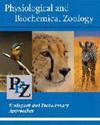蝙蝠Torpor表达的普遍性
IF 1.8
3区 生物学
Q3 PHYSIOLOGY
引用次数: 6
摘要
尽管翼手目(蝙蝠)中的物种在全球范围内采用了异温法,但只有在过去几十年里,人们才探索到栖息在温暖气候区的蝙蝠物种表现迟钝的可能性。最近的研究表明,表达迟钝的好处不仅限于在寒冷或食物短缺期间节省能源,而且可能对在热浪期间节约用水同样重要。因此,即使蝙蝠面临的生理挑战可能取决于它们生活的栖息地,在任何气候区都应该发现表达迟钝的物种,在那里使用迟钝可以带来好处并增加它们的生存概率。在这里,我们总结了不同气候区蝙蝠迟钝代谢率和每日皮肤温度模式的可用数据,强调了数据中的相似性。我们还介绍了我们从南亚热带物种(双弯弯线虫)和北亚北极物种(耳丛蝙蝠)收集的数据,以说明生活在高度不同环境中的两种蝙蝠迟钝表达的具体例子。我们的研究结果强调,蝙蝠在冬眠季节之外的迟钝代谢率和皮肤温度模式在截然不同的栖息地中可能是普遍的,尽管干旱环境表明,与居住在其他气候区的种群的测量结果相比,平均最低迟钝代谢率可能存在差异。本文章由计算机程序翻译,如有差异,请以英文原文为准。
Universality of Torpor Expression in Bats
Although heterothermy is employed by species at a global level within the order of Chiroptera (bats), the possibility of torpor being expressed in bat species inhabiting warmer climate zones has been explored only in the past couple decades. Recent studies suggest that the benefit of expressing torpor is not limited to saving energy during cold exposure or food shortage but may be just as important for saving water during heat waves. Thus, even if the physiological challenges faced by bats may depend on the habitat they live in, species expressing torpor should be found in any climate zone where employing torpor may yield benefits and increase their survival probability. Here, we summarize available data on torpor metabolic rates and daily skin temperature patterns of bats across climate zones, emphasizing similarities found in the data. We also present data that we have collected from a southern subtropical species (Nyctophilus bifax) and a northern subarctic species (Plecotus auritus) to illustrate specific examples of torpor expressions in two bat species living in highly different environments. Our findings highlight that torpor metabolic rates and skin temperature patterns of bats outside of the hibernation season can be universal across vastly different habitats, although arid environments indicate potential divergence in mean minimum torpor metabolic rates compared with measurements of populations inhabiting other climate zones.
求助全文
通过发布文献求助,成功后即可免费获取论文全文。
去求助
来源期刊
CiteScore
3.20
自引率
6.20%
发文量
62
审稿时长
6-12 weeks
期刊介绍:
Physiological and Biochemical Zoology: Ecological and Evolutionary Approaches primarily publishes original research in animal physiology and biochemistry as considered from behavioral, ecological, and/or evolutionary perspectives. Studies at all levels of biological organization from the molecular to the whole organism are welcome, and work that integrates across levels of organization is particularly encouraged. Studies that focus on behavior or morphology are welcome, so long as they include ties to physiology or biochemistry, in addition to having an ecological or evolutionary context.
Subdisciplines of interest include nutrition and digestion, salt and water balance, epithelial and membrane transport, gas exchange and transport, acid-base balance, temperature adaptation, energetics, structure and function of macromolecules, chemical coordination and signal transduction, nitrogen metabolism and excretion, locomotion and muscle function, biomechanics, circulation, behavioral, comparative and mechanistic endocrinology, sensory physiology, neural coordination, and ecotoxicology ecoimmunology.

 求助内容:
求助内容: 应助结果提醒方式:
应助结果提醒方式:


